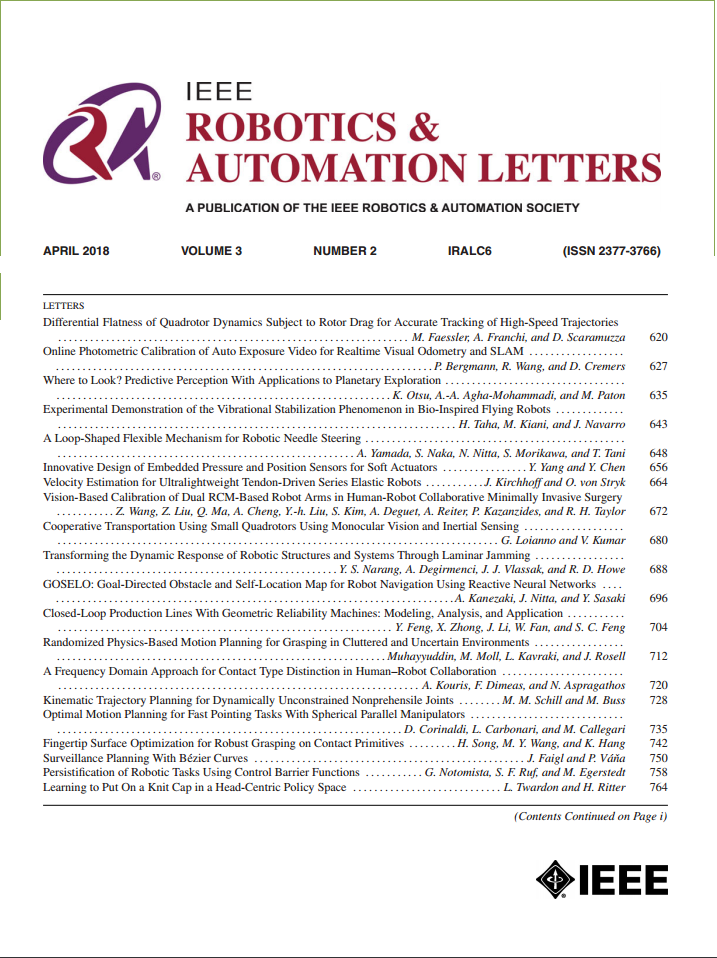Closed-Loop Shape-Forming Control of a Magnetic Soft Continuum Robot
IF 4.6
2区 计算机科学
Q2 ROBOTICS
引用次数: 0
Abstract
Continuum manipulators are frequently employed in endoluminal interventions, however, a lack of softness and dexterity in standard manipulators can risk trauma during navigation and limit reachable workspace. Magnetically actuated Soft Continuum Robots (MSCRs) offer enhanced miniaturization potential and reduced rigidity due to their external actuation. Magnetizations pertaining only to the tip of the robot offer a limited range of deformation options where more versatile MSCRs can be embedded with distinct, lengthwise magnetization profiles. These full-body bespoke profiles allow the robots to form pre-determined shapes under actuation. Here we propose an approach to model and control MSCR behavior in closed-loop. We employ this system to achieve shape forming navigations subject to variations in initial conditions. To validate our methodology, we conduct experiments using a 50 mm long by 1.8 mm diameter MSCR navigating through a soft phantom from the tip of a duodenoscope. The proposed system is capable of rejecting variations in the angle at which the MSCR is inserted. We employed homogeneous magnetic fields for actuation and closed-loop vision-based control to manipulate the lengthwise body shape of our MSCR. The performance of this closed-loop approach is compared with an open loop counterpart, which fails in all but one navigation attempts into the pancreatic duct.磁性软连续体机器人的闭环成形控制
连续机械臂经常用于腔内干预,然而,标准机械臂缺乏柔软性和灵活性,可能会在导航过程中造成创伤,并限制可达的工作空间。磁驱动软连续体机器人(MSCRs)提供增强的小型化潜力和降低刚性,由于其外部驱动。磁化仅适用于机器人的尖端提供了有限范围的变形选择,更通用的mscr可以嵌入不同的纵向磁化剖面。这些全身定制的轮廓允许机器人在驱动下形成预定的形状。本文提出了一种在闭环环境下对MSCR行为进行建模和控制的方法。我们使用该系统来实现受初始条件变化影响的形状形成导航。为了验证我们的方法,我们进行了实验,使用50毫米长、1.8毫米直径的MSCR从十二指肠镜的尖端穿过软影。所提出的系统能够拒绝MSCR插入角度的变化。我们采用均匀磁场驱动和基于视觉的闭环控制来控制我们的MSCR的纵向形状。将这种闭环方法的性能与开环方法进行比较,开环方法除了一次进入胰管的导航尝试外,其他都失败了。
本文章由计算机程序翻译,如有差异,请以英文原文为准。
求助全文
约1分钟内获得全文
求助全文
来源期刊

IEEE Robotics and Automation Letters
Computer Science-Computer Science Applications
CiteScore
9.60
自引率
15.40%
发文量
1428
期刊介绍:
The scope of this journal is to publish peer-reviewed articles that provide a timely and concise account of innovative research ideas and application results, reporting significant theoretical findings and application case studies in areas of robotics and automation.
 求助内容:
求助内容: 应助结果提醒方式:
应助结果提醒方式:


